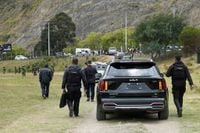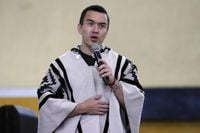When President Daniel Noboa set out for a routine visit to El Tambo, a small town nestled in Ecuador’s southern highlands, he likely expected a day of handshakes and ribbon-cutting. Instead, on October 7, 2025, his motorcade was met by a furious crowd of roughly 500 protesters—an encounter that would soon be described by government officials as nothing less than an assassination attempt. According to reports from the Associated Press and Latin American Post, the convoy was pelted with rocks, the road was littered with concrete debris, and, according to Environment and Energy Minister Inés Manzano, bullet marks were later discovered on the president’s vehicle. The president himself, however, emerged unscathed.
What happened in El Tambo is not an isolated incident, but rather the latest—and most dramatic—episode in a wave of unrest that has swept Ecuador since mid-September. The spark for this turmoil was President Noboa’s controversial decision on September 13 to eliminate a longstanding diesel subsidy, a move that sent fuel prices soaring from $1.80 to $2.80 per gallon overnight. The government argued the cut was necessary to plug fiscal deficits and redirect funds to social programs. But for many Ecuadorians, particularly in Indigenous and rural communities, the subsidy was a lifeline. Its removal has made everything from bus fares to basic groceries more expensive, and the backlash was swift and fierce.
Within days, the Confederation of Indigenous Nationalities of Ecuador (CONAIE), the country’s most powerful social movement, announced an immediate and indefinite national strike. Protests erupted across the country, with roadblocks severing key supply routes, truckers idling in frustration, and farmers struggling to get their produce to market. In Quito, supermarkets reported thinning shelves as the unrest spread from the highlands to the coast. The government responded by declaring a state of emergency in ten provinces on October 5, granting the military broad powers to control the unrest.
Things reached a boiling point in El Tambo. As Noboa’s black Suburban attempted to make its way through a roadblock, rocks and—according to some government officials—gunfire rained down. Tear gas filled the air, and five suspects were quickly arrested on charges of terrorism and attempted murder. Yet, just a day later, a judge declared their arrest illegal and ordered their release, a decision that left prosecutors unable to press charges. The Attorney General’s Office acknowledged the setback on social platform X, highlighting the legal and political complexities at play.
Government officials wasted no time framing the incident as an attack on the nation’s democracy. Defense Minister Gian Carlo Loffredo told local media, “The level of aggression with which they attacked the caravan shows that this was a clear assassination attempt and an act of terrorism against the president.” Interior Minister John Reimberg went further, blaming the violence on “a deliberate effort to destabilize the country.” President Noboa himself struck a defiant tone, declaring, “We will continue working without fear.”
But not everyone saw the event through the same lens. CONAIE and other Indigenous leaders dismissed the government’s claims as political theater—a calculated move, they argued, to justify harsh crackdowns on legitimate dissent. “This is a provocation designed to criminalize protest and distract from Ecuador’s social crisis,” CONAIE stated in a communiqué. Marlon Vargas, the group’s president, threatened to mobilize supporters to Quito if the government did not reverse the diesel decision and lower the value-added tax. “We are not terrorists. We are the ones defending life,” an Indigenous leader emphasized outside the capital.
The protests have already exacted a heavy toll. Nearly 100 people have been detained since mid-September, and at least one civilian has died in clashes with police. Human rights organizations have raised alarms over what they describe as heavy-handed repression against demonstrators exercising their constitutional rights to peaceful assembly. The government, meanwhile, insists that removing the subsidy is a painful but necessary step to stabilize Ecuador’s economy, which has been battered by debt and stagnation for years.
International observers have taken notice. U.N. Secretary-General António Guterres condemned the violence against Noboa’s motorcade and called for restraint and inclusive dialogue to resolve the crisis peacefully. The U.S. State Department echoed these sentiments, stating, “We stand with Ecuador as authorities investigate and ensure accountability, and stand against all forms of political violence.”
The episode in El Tambo was not the first attack on Noboa’s convoy in recent weeks. In September, a similar ambush occurred in Imbabura province, where protesters used fireworks, Molotov cocktails, and rocks against vehicles carrying the president and foreign diplomats. Both incidents highlight the growing risks faced by Ecuador’s leaders as economic woes deepen and public trust erodes.
At the heart of the unrest lies a fundamental clash between Ecuador’s urban elites and its Indigenous and rural populations. Fuel subsidies have long been a political pressure valve, cushioning the poor from inflation and economic shocks. Past efforts to remove them have sparked mass mobilizations that toppled governments, as seen in 2019 when President Lenín Moreno was forced to flee Quito amid nationwide protests. Noboa, elected in 2023 as the country’s youngest president, campaigned on promises of security and economic reform. Now, his technocratic vision of austerity is colliding head-on with the everyday realities of those who feel left behind.
For Indigenous communities, the fight is about more than fuel. It’s about dignity, inclusion, and survival in a system they see as stacked against them. The government’s decision to label protesters as terrorists has only deepened the divide. “Every reform seems to ask the poor to pay first,” critics argue, pointing to Noboa’s close alignment with international investors and his embrace of militarized security policies.
As the investigation into the El Tambo incident continues, questions remain about what exactly transpired. Reuters has noted the difficulty in independently verifying whether gunfire occurred, underscoring the challenge of discerning fact from political spin amid a climate of distrust. What is clear, however, is that Ecuador stands at a crossroads. The cracked glass of the president’s convoy has become a symbol of a nation on edge—its democracy battered, but not yet broken.
In this moment of crisis, the path forward will depend on whether Noboa can bridge the widening gulf between his administration and the people he governs. The choice is stark: confrontation or dialogue, repression or reform. The future of Ecuador’s fragile democracy may hinge on which road its young president chooses to take.


